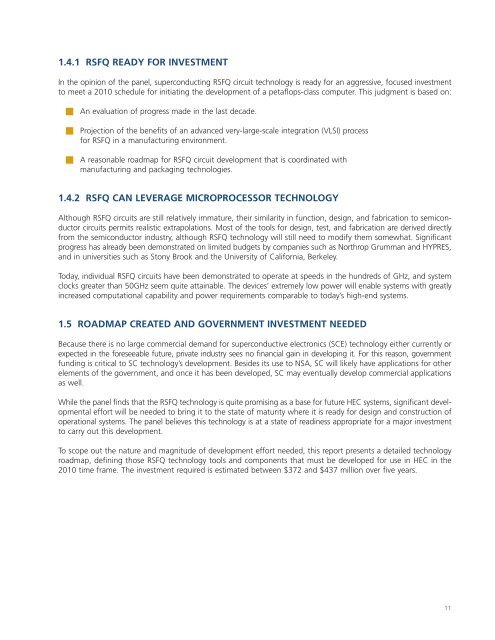Superconducting Technology Assessment - nitrd
Superconducting Technology Assessment - nitrd
Superconducting Technology Assessment - nitrd
You also want an ePaper? Increase the reach of your titles
YUMPU automatically turns print PDFs into web optimized ePapers that Google loves.
1.4.1 RSFQ READY FOR INVESTMENT<br />
In the opinion of the panel, superconducting RSFQ circuit technology is ready for an aggressive, focused investment<br />
to meet a 2010 schedule for initiating the development of a petaflops-class computer. This judgment is based on:<br />
■ An evaluation of progress made in the last decade.<br />
■ Projection of the benefits of an advanced very-large-scale integration (VLSI) process<br />
for RSFQ in a manufacturing environment.<br />
■ A reasonable roadmap for RSFQ circuit development that is coordinated with<br />
manufacturing and packaging technologies.<br />
1.4.2 RSFQ CAN LEVERAGE MICROPROCESSOR TECHNOLOGY<br />
Although RSFQ circuits are still relatively immature, their similarity in function, design, and fabrication to semiconductor<br />
circuits permits realistic extrapolations. Most of the tools for design, test, and fabrication are derived directly<br />
from the semiconductor industry, although RSFQ technology will still need to modify them somewhat. Significant<br />
progress has already been demonstrated on limited budgets by companies such as Northrop Grumman and HYPRES,<br />
and in universities such as Stony Brook and the University of California, Berkeley.<br />
Today, individual RSFQ circuits have been demonstrated to operate at speeds in the hundreds of GHz, and system<br />
clocks greater than 50GHz seem quite attainable. The devices’ extremely low power will enable systems with greatly<br />
increased computational capability and power requirements comparable to today’s high-end systems.<br />
1.5 ROADMAP CREATED AND GOVERNMENT INVESTMENT NEEDED<br />
Because there is no large commercial demand for superconductive electronics (SCE) technology either currently or<br />
expected in the foreseeable future, private industry sees no financial gain in developing it. For this reason, government<br />
funding is critical to SC technology’s development. Besides its use to NSA, SC will likely have applications for other<br />
elements of the government, and once it has been developed, SC may eventually develop commercial applications<br />
as well.<br />
While the panel finds that the RSFQ technology is quite promising as a base for future HEC systems, significant developmental<br />
effort will be needed to bring it to the state of maturity where it is ready for design and construction of<br />
operational systems. The panel believes this technology is at a state of readiness appropriate for a major investment<br />
to carry out this development.<br />
To scope out the nature and magnitude of development effort needed, this report presents a detailed technology<br />
roadmap, defining those RSFQ technology tools and components that must be developed for use in HEC in the<br />
2010 time frame. The investment required is estimated between $372 and $437 million over five years.<br />
11










